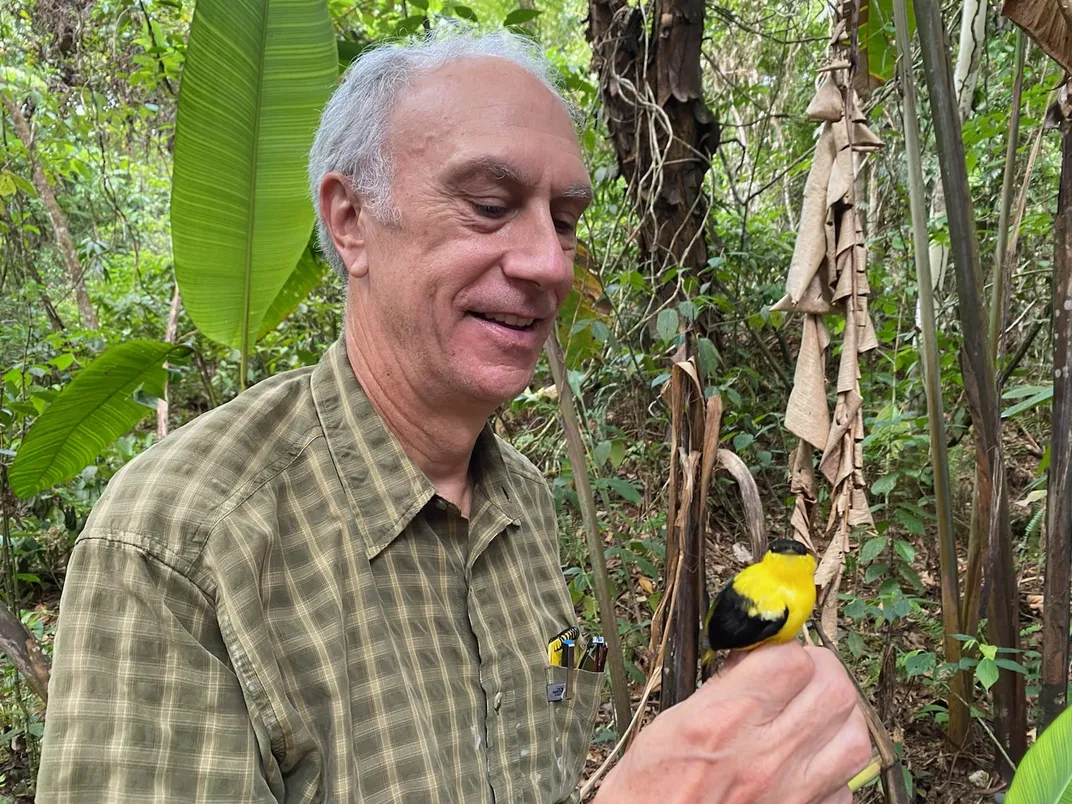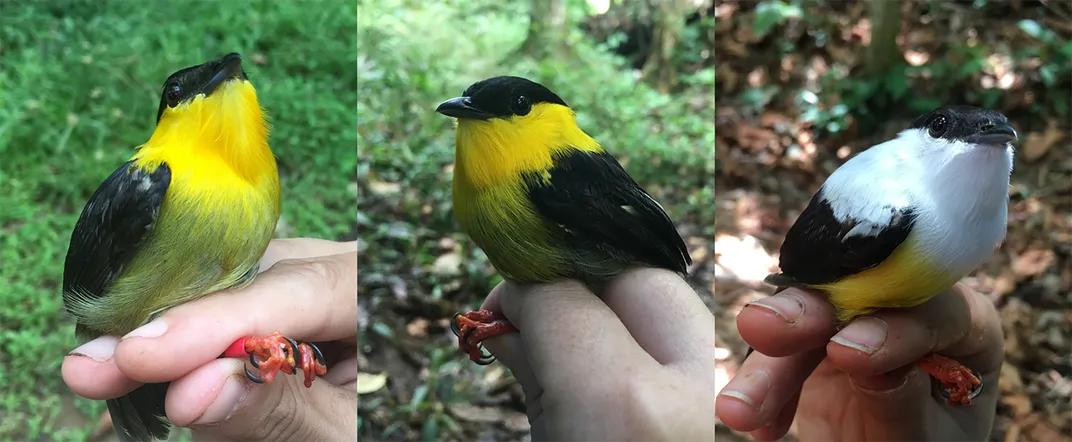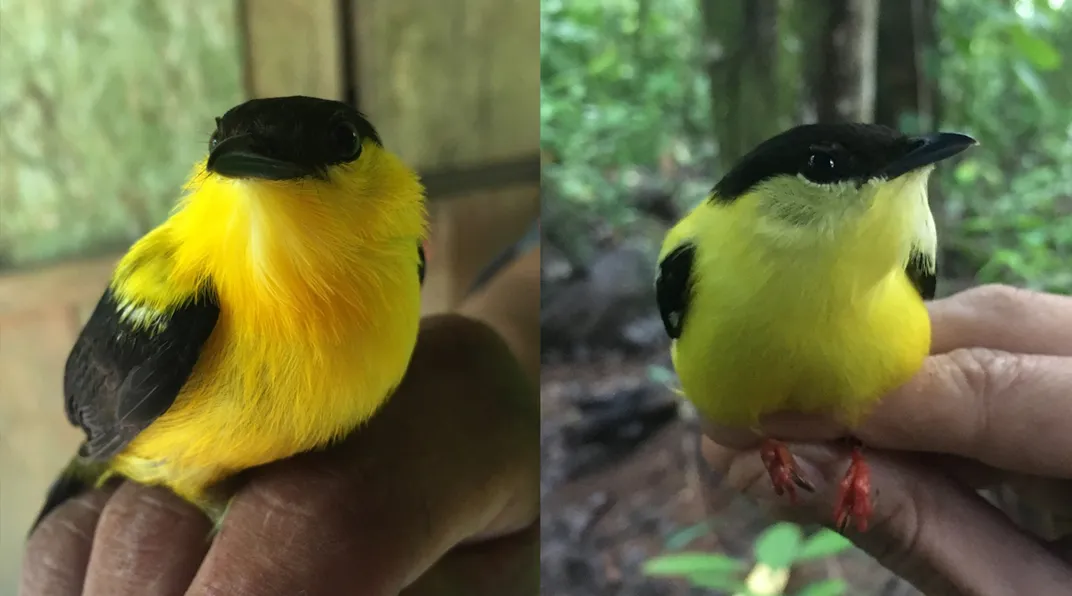An adult male hybrid manakin from Bastimentos Island, Bocas del Toro, Panama.
Thomas Parsons
Do not let the diminutive dimensions of a manakin fool you. Despite only weighing as much as a AA battery, these birds have charisma to spare and are amazing avian acrobats.
Nearly 60 species of manakins are found throughout the tropics of Central and South America. While female manakins are usually drab in color, male manakins pop in a variety of shades from ruby red to neon blue. The only thing more eye-catching than the males’ color is their smooth moves. When it is time to woo prospective mates, male manakins swiftly dart between tree saplings, creating a bouncing blur of color. These dances are accompanied by loud sounds reminiscent of crackling firecrackers that the birds produce by snapping their wings together.
These complex courtship rituals have made manakins legendary amongst behavioral ecologists. They have also made the birds intriguing from an evolutionary biology perspective. “Their entire evolutionary history has been shaped by the intense selection that males undergo,” said Michael Braun, a research zoologist in the National Museum of Natural History’s Department of Vertebrate Zoology. “They represent this really interesting example of sexual selection, which is one of the major driving forces that create the diversity we see in nature.”
Braun and his colleagues have studied manakins for decades. Much of this work has focused on birds living in the Bocas del Toro region of western Panama. Here, golden-collared manakins (Manacus vitellinus) and white-collared manakins (Manacus candei) have intermingled for thousands of years, creating what Braun calls a “manakin melting pot.”

Research zoologist Michael Braun holds a hybrid manakin while doing field work in Panama.
Kevin Bennett
Regions where multiple species regularly interbreed are known as hybrid zones. These dynamic areas act like living evolutionary laboratories, offering glimpses of how boundaries between species are shifting over time and space. “Avian hybrid zones have always interested me because they give insights into how new species arise in nature,” Braun said.
Braun first became interested in studying the manakin hybrid zone shortly after he completed his PhD and applied for a job at the Smithsonian Tropical Research Institute in Panama. He knew that the ranges of golden and white-collared manakins overlapped in this area, but little work had been done to determine whether the two species hybridize. When he arrived at the museum to help start a molecular genetics program 36 years ago, he finally had access to manakin specimens from this part of Panama.
To understand how the local manakins intermingle, Braun and his colleagues rely on genetic clues preserved in tissue samples. Comparing genetic information is more accurate than observing the birds themselves because looks can be deceiving. For example, most manakin hybrids sport bright yellow necks and dark green bellies, making them nearly indistinguishable from purebred golden-collared manakins.

In the Bocas del Toro Archipelago off of Panama, golden-collared manakins (left) and white-collared manakins (right) regularly interbreed, creating hybrids (middle) that resemble their golden-collared parents, even while carrying the genomes of their white-collared parents.
Kira Long
Taking a genetic approach has helped scientists tease apart how hybrid and purebred manakins are melding. Recently, Braun worked with Kira Long, a conservation geneticist then at the University of Illinois and now at the Smithsonian National Zoo and Conservation Biology Institute, to determine how manakin populations have changed in the hybrid zone over time. The team collected blood samples and color measurements from local manakins and compared them with specimens at the museum that were collected in the same area 30 years ago.
Their findings, published in the journal Evolution in May, found that local manakin populations have remained genetically stable over the past three decades with hybrid manakins maintaining a strong population among their pure-bred peers. The success of manakin hybrids is surprising as many hybrids struggle to produce viable offspring. For example, mules (a cross between a donkey and a horse) are sterile. But sometimes hybrids have advantages over their parent species that help them carve out a niche in the wild.
Hybrid manakins may have a genetic advantage over their pure-bred parent species. In another paper published in Molecular Ecology in August, Braun, Long and colleagues, including Ben Vernasco of Whitman College, examined the DNA of manakin hybrids to measure the lengths of the birds’ telomeres, the structures at the end of a chromosome that impact how long cells can divide. The length of telomeres can correlate to an animal’s lifespan and longevity, and Braun and his colleagues found that hybrid manakins had longer telomeres than pure-bred manakins. “Just like a mule is stronger than a horse or a donkey, we think that manakin hybrids that have longer telomeres may be performing better at some physiological functions than their parents,” Braun said.

Around 9,000 years ago, rising sea levels isolated a string of islands now known as the Bocas del Toro Archipelago. The Smithsonian Tropical Research Institute has a center here where researchers study a range of local species, including manatees, poison-dart frogs and manakins.
Smithsonian Tropical Research Institute
While Panama’s hybrid manakin population is stable, it is far from static. The Evolution paper discovered that the belly feathers of hybrid manakins have become a darker shade of green in recent decades. According to Braun, this may be due to sexual selection: male manakins with yellow collars and green bellies are generally more aggressive than white-collared manakins, which helps them secure mates and sire more offspring.
The color of these birds’ namesake collars are also changing. This month, Braun worked with several colleagues including Haw Chuan Lim, an evolutionary biologist at George Mason University who is also affiliated with the National Zoo, Kevin Bennett, an evolutionary genomicist affiliated with the museum and the University of Maryland and a group of avian color specialists led by Geoff Hill at Auburn University to study the plumage coloration of golden and white-collared manakins across the hybrid zone. Their findings, published this month in the journal Science Advances, discovered that the gene responsible for the yellow color of golden-collared manakins is gradually replacing white plumage in the population. “In this case, we’re pretty confident that female white-collared manakins prefer to breed with male golden-collared manakins, which is why the plumage traits have shifted,” Braun said.
The hybridization of these manakins is more complex than previously thought. The scientists found that the gene linked to color in golden-collared manakins originated from a third species, the orange-collared manakin. Lim thinks this process of specific genes crossing species boundaries is more common than previously thought. “Our findings show that evolution can take surprising turns, with species sometimes forming as genomic mosaics that integrate genetic materials from multiple species through hybridization,” he said.

Two hybrid manakin morphs with yellow feathers similar to the plumage of golden-collared manakins.
Kira Long
While this recent suite of studies sheds light on the current state of Panama’s manakin hybrid zone, this dynamic environment will continue to drive manakin evolution in different directions. And being able to witness these changes represents a scientific boon for Braun.
“When we study diversity in nature, we’re often looking at evolutionary processes that took place in the deep past,” he said. “So to actually observe these processes taking place and track genetic changes as diversification occurs is a special situation. This is why hybrid zones remain so exciting.”
Related Stories
How Lugging a Liquid Nitrogen Tank into the Amazon Helped Spark Ornithology’s Genetic Revolution
The Murder Mystery Linking a Bird Specimen at the National Museum of Natural History to the Mysterious Death of an Arctic Explorer
Tiny Tornado Chasers: Why Rare Songbirds Rely on Destructive Winds
Across the Smithsonian, Researchers are Working Together to Save Virginia’s Birds
Birds
Evolution
Field Work
Genes
Genetics
Genomics
Global Genome Initiative
Research
Tropics
Author :
Publish date : 2024-11-21 04:35:00
Copyright for syndicated content belongs to the linked Source.
—-
Author : theamericannews
Publish date : 2024-11-23 11:23:21
Copyright for syndicated content belongs to the linked Source.